文件夹权限的批量修改
windows应用场景下批量修改文件所有者的批处理脚本
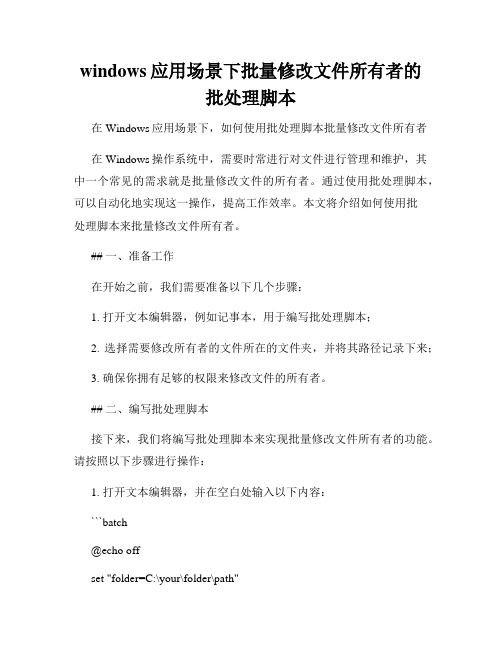
windows应用场景下批量修改文件所有者的批处理脚本在Windows应用场景下,如何使用批处理脚本批量修改文件所有者在Windows操作系统中,需要时常进行对文件进行管理和维护,其中一个常见的需求就是批量修改文件的所有者。
通过使用批处理脚本,可以自动化地实现这一操作,提高工作效率。
本文将介绍如何使用批处理脚本来批量修改文件所有者。
## 一、准备工作在开始之前,我们需要准备以下几个步骤:1. 打开文本编辑器,例如记事本,用于编写批处理脚本;2. 选择需要修改所有者的文件所在的文件夹,并将其路径记录下来;3. 确保你拥有足够的权限来修改文件的所有者。
## 二、编写批处理脚本接下来,我们将编写批处理脚本来实现批量修改文件所有者的功能。
请按照以下步骤进行操作:1. 打开文本编辑器,并在空白处输入以下内容:```batch@echo offset "folder=C:\your\folder\path"set "newOwner=NewOwner"icacls "%folder%" /setowner "%newOwner%" /t /c```2. 请将`C:\your\folder\path`替换为你要修改所有者的文件夹路径。
例如,如果你要修改`D:\MyFiles`文件夹下所有文件的所有者,则将路径替换为`D:\MyFiles`;3. 将`NewOwner`替换为你想要设置的新所有者的用户名;4. 将上述内容保存为`.bat`文件,例如`change_owner.bat`。
## 三、运行批处理脚本完成编写批处理脚本后,我们将进行以下步骤来运行它:1. 双击运行`change_owner.bat`文件;2. 批处理脚本将会自动执行,修改指定文件夹下所有文件的所有者为设定的新所有者;3. 若文件较多,该操作可能需要一些时间,请耐心等待。
批量修改Win7文件权限
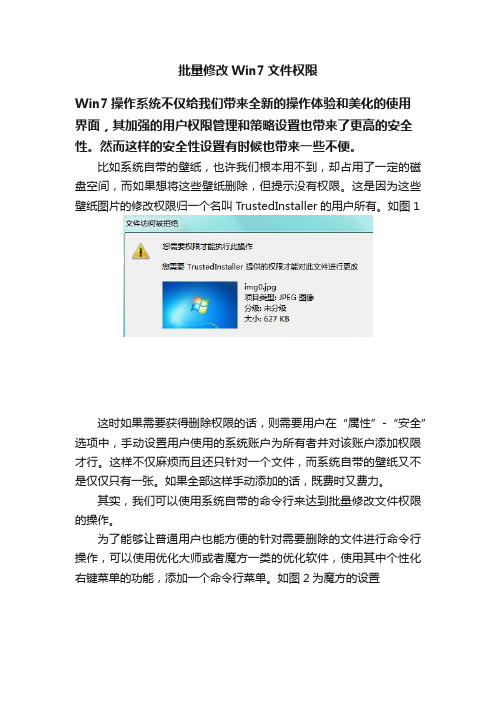
批量修改Win7文件权限Win7操作系统不仅给我们带来全新的操作体验和美化的使用界面,其加强的用户权限管理和策略设置也带来了更高的安全性。
然而这样的安全性设置有时候也带来一些不便。
比如系统自带的壁纸,也许我们根本用不到,却占用了一定的磁盘空间,而如果想将这些壁纸删除,但提示没有权限。
这是因为这些壁纸图片的修改权限归一个名叫TrustedInstaller的用户所有。
如图1这时如果需要获得删除权限的话,则需要用户在“属性”-“安全”选项中,手动设置用户使用的系统账户为所有者并对该账户添加权限才行。
这样不仅麻烦而且还只针对一个文件,而系统自带的壁纸又不是仅仅只有一张。
如果全部这样手动添加的话,既费时又费力。
其实,我们可以使用系统自带的命令行来达到批量修改文件权限的操作。
为了能够让普通用户也能方便的针对需要删除的文件进行命令行操作,可以使用优化大师或者魔方一类的优化软件,使用其中个性化右键菜单的功能,添加一个命令行菜单。
如图2为魔方的设置这样就能方便的在需要删除的文件夹上单击右键菜单来快速的进入命令行设置了。
如图3进入命令行窗口后,首先需要输入命令:takeown /f * /A /R小知识:Takeown命令用于以重新分配文件所有权的方式允许管理员重新获取先前被拒绝访问的文件访问权。
/f 参数作用在于指定文件名或目录名模式。
可以用通配符"*",“*”在这里的作用是充当任意字符。
/a 参数用于将所有权给于管理员组,而不是当前用户/r 参数用于递归: 指示本命令运行于指定的目录和子目录里的文件上如命令执行成功,则会出现如图4所示的提示随后再输入命令:icacls * /t /grant:r everyone:f小知识:icacls 命令用于查看、设置、保存并恢复文件夹或文件的权限* 表示任意字符/T 参数用以该命令指定的目录下的所有匹配文件/目录上执行此操作/grant:r everyone参数用以授予everyone用户访问权限,并替换以前授予的所有显式权限如命令成功执行,则会出现如图5所示提示完成以上操作后,再对刚才提示没有权限的壁纸文件进行删除操作,系统就不会提示没有权限了,而是提示是否需要将文件移入回收站,如图6。
批量修改NTFS权限、删除未知帐户
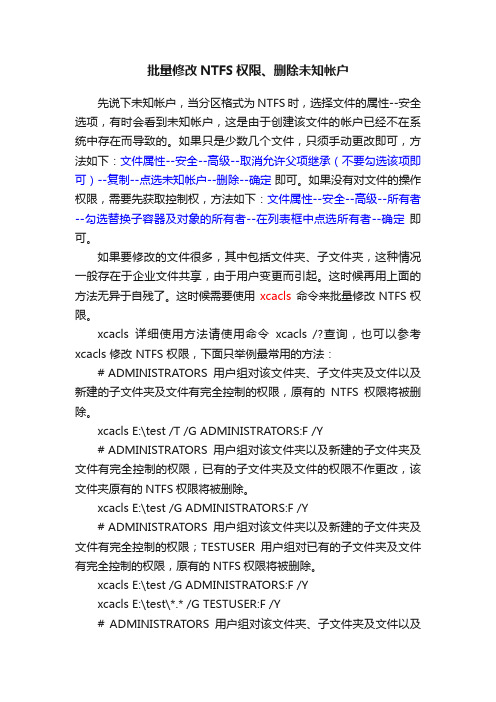
批量修改NTFS权限、删除未知帐户先说下未知帐户,当分区格式为NTFS时,选择文件的属性--安全选项,有时会看到未知帐户,这是由于创建该文件的帐户已经不在系统中存在而导致的。
如果只是少数几个文件,只须手动更改即可,方法如下:文件属性--安全--高级--取消允许父项继承(不要勾选该项即可)--复制--点选未知帐户--删除--确定即可。
如果没有对文件的操作权限,需要先获取控制权,方法如下:文件属性--安全--高级--所有者--勾选替换子容器及对象的所有者--在列表框中点选所有者--确定即可。
如果要修改的文件很多,其中包括文件夹、子文件夹,这种情况一般存在于企业文件共享,由于用户变更而引起。
这时候再用上面的方法无异于自残了。
这时候需要使用xcacls 命令来批量修改NTFS权限。
xcacls详细使用方法请使用命令xcacls /?查询,也可以参考xcacls 修改 NTFS 权限,下面只举例最常用的方法:# ADMINISTRATORS用户组对该文件夹、子文件夹及文件以及新建的子文件夹及文件有完全控制的权限,原有的NTFS权限将被删除。
xcacls E:\test /T /G ADMINISTRATORS:F /Y# ADMINISTRATORS用户组对该文件夹以及新建的子文件夹及文件有完全控制的权限,已有的子文件夹及文件的权限不作更改,该文件夹原有的NTFS权限将被删除。
xcacls E:\test /G ADMINISTRATORS:F /Y# ADMINISTRATORS用户组对该文件夹以及新建的子文件夹及文件有完全控制的权限;TESTUSER用户组对已有的子文件夹及文件有完全控制的权限,原有的NTFS权限将被删除。
xcacls E:\test /G ADMINISTRATORS:F /Yxcacls E:\test\*.* /G TESTUSER:F /Y# ADMINISTRATORS用户组对该文件夹、子文件夹及文件以及新建的子文件夹及文件有完全控制的权限;TESTUSER用户组对该文件夹及新建的子文件夹有读写的权限,对新建的文件有读写删除执行的权限;分号前定义的权限由新建的子文件夹及文件继承,但仅对文件有效;分号后定义的权限仅由新建的子文件夹继承,且仅对文件夹生效。
如何解决Windows系统中的文件权限问题
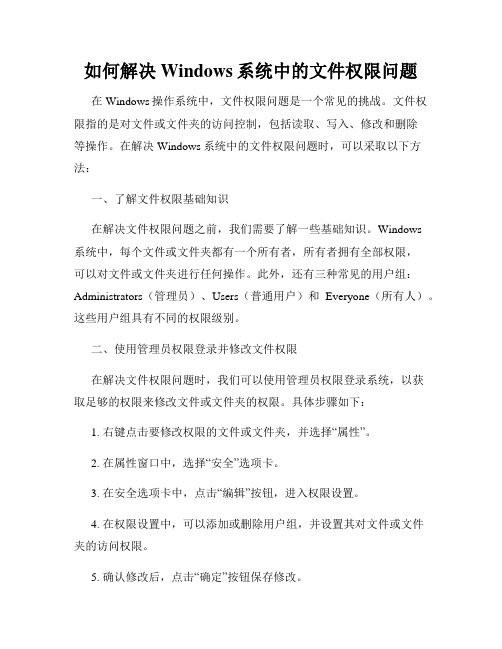
如何解决Windows系统中的文件权限问题在Windows操作系统中,文件权限问题是一个常见的挑战。
文件权限指的是对文件或文件夹的访问控制,包括读取、写入、修改和删除等操作。
在解决Windows系统中的文件权限问题时,可以采取以下方法:一、了解文件权限基础知识在解决文件权限问题之前,我们需要了解一些基础知识。
Windows系统中,每个文件或文件夹都有一个所有者,所有者拥有全部权限,可以对文件或文件夹进行任何操作。
此外,还有三种常见的用户组:Administrators(管理员)、Users(普通用户)和Everyone(所有人)。
这些用户组具有不同的权限级别。
二、使用管理员权限登录并修改文件权限在解决文件权限问题时,我们可以使用管理员权限登录系统,以获取足够的权限来修改文件或文件夹的权限。
具体步骤如下:1. 右键点击要修改权限的文件或文件夹,并选择“属性”。
2. 在属性窗口中,选择“安全”选项卡。
3. 在安全选项卡中,点击“编辑”按钮,进入权限设置。
4. 在权限设置中,可以添加或删除用户组,并设置其对文件或文件夹的访问权限。
5. 确认修改后,点击“确定”按钮保存修改。
三、使用命令行工具修改文件权限除了通过图形界面修改文件权限外,我们还可以通过命令行工具来实现。
使用命令行工具可以批量修改文件权限,提高效率。
具体步骤如下:1. 打开命令提示符,以管理员身份运行。
2. 使用命令“icacls”或“cacls”来修改文件或文件夹的权限。
3. 通过命令参数设置对应的权限级别。
4. 输入命令后,系统会自动修改文件或文件夹的权限。
四、使用安全软件管理文件权限为了更加方便地管理文件权限,我们可以使用一些安全软件,如Windows内置的“Windows Defender”或第三方安全软件。
这些软件提供了图形界面,可以直观地管理文件权限,同时还具备实时保护功能,可以防止恶意程序修改文件权限。
五、修复系统文件权限有时,系统文件权限出现问题可能导致某些功能无法正常使用。
Linux命令高级技巧利用find与xargs命令进行批量文件权限的修改与管理
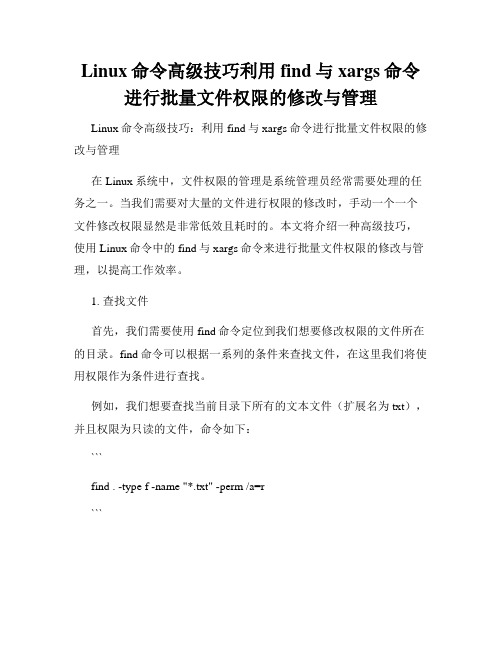
Linux命令高级技巧利用find与xargs命令进行批量文件权限的修改与管理Linux命令高级技巧:利用find与xargs命令进行批量文件权限的修改与管理在Linux系统中,文件权限的管理是系统管理员经常需要处理的任务之一。
当我们需要对大量的文件进行权限的修改时,手动一个一个文件修改权限显然是非常低效且耗时的。
本文将介绍一种高级技巧,使用Linux命令中的find与xargs命令来进行批量文件权限的修改与管理,以提高工作效率。
1. 查找文件首先,我们需要使用find命令定位到我们想要修改权限的文件所在的目录。
find命令可以根据一系列的条件来查找文件,在这里我们将使用权限作为条件进行查找。
例如,我们想要查找当前目录下所有的文本文件(扩展名为txt),并且权限为只读的文件,命令如下:```find . -type f -name "*.txt" -perm /a=r```上述命令中,“.”表示当前目录,“-type f”表示只查找文件而不包括目录,“-name "*.txt"”表示查找扩展名为txt的文件,“-perm /a=r”表示查找权限为只读的文件。
2. 修改文件权限找到满足条件的文件后,我们可以使用xargs命令将这些文件的路径传递给下一个命令,进而修改文件的权限。
例如,我们想要将上一步找到的只读文件的权限改为可读可写,命令如下:```find . -type f -name "*.txt" -perm /a=r | xargs chmod 644```上述命令中,“|”是管道操作符,将find命令的结果传递给xargs命令,“chmod 644”表示将文件的权限改为可读可写。
3. 批量修改权限有时候,我们可能需要对整个目录中的所有文件都进行权限的修改。
这时候,我们可以使用通配符来简化命令。
例如,我们想要将当前目录下所有的Shell脚本文件(扩展名为sh)的权限改为可执行,命令如下:```find . -type f -name "*.sh" | xargs chmod +x```上述命令中,“chmod +x”表示将文件的权限改为可执行。
文件夹权限不够的解决方法
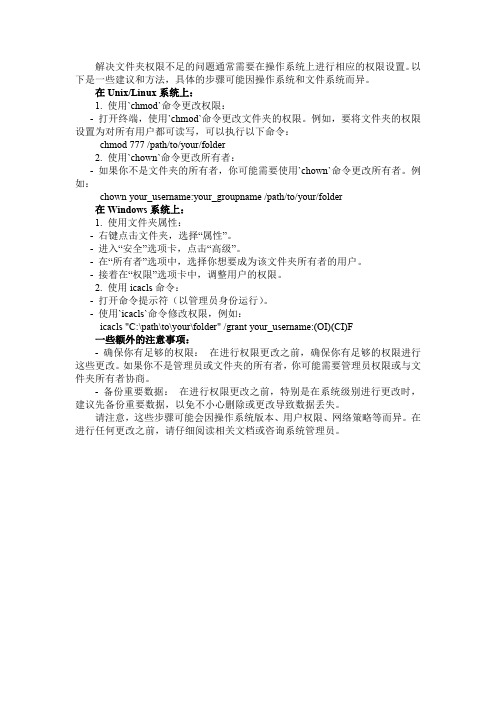
解决文件夹权限不足的问题通常需要在操作系统上进行相应的权限设置。
以下是一些建议和方法,具体的步骤可能因操作系统和文件系统而异。
在Unix/Linux系统上:1. 使用`chmod`命令更改权限:-打开终端,使用`chmod`命令更改文件夹的权限。
例如,要将文件夹的权限设置为对所有用户都可读写,可以执行以下命令:chmod 777 /path/to/your/folder2. 使用`chown`命令更改所有者:-如果你不是文件夹的所有者,你可能需要使用`chown`命令更改所有者。
例如:chown your_username:your_groupname /path/to/your/folder在Windows系统上:1. 使用文件夹属性:-右键点击文件夹,选择“属性”。
-进入“安全”选项卡,点击“高级”。
-在“所有者”选项中,选择你想要成为该文件夹所有者的用户。
-接着在“权限”选项卡中,调整用户的权限。
2. 使用icacls命令:-打开命令提示符(以管理员身份运行)。
-使用`icacls`命令修改权限,例如:icacls "C:\path\to\your\folder" /grant your_username:(OI)(CI)F一些额外的注意事项:-确保你有足够的权限:在进行权限更改之前,确保你有足够的权限进行这些更改。
如果你不是管理员或文件夹的所有者,你可能需要管理员权限或与文件夹所有者协商。
-备份重要数据:在进行权限更改之前,特别是在系统级别进行更改时,建议先备份重要数据,以免不小心删除或更改导致数据丢失。
请注意,这些步骤可能会因操作系统版本、用户权限、网络策略等而异。
在进行任何更改之前,请仔细阅读相关文档或咨询系统管理员。
如何使用chown和chmod命令修改文件权限和所有权
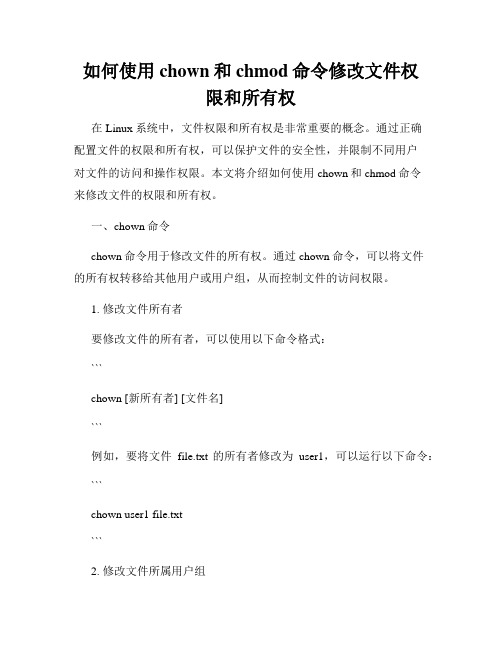
如何使用chown和chmod命令修改文件权限和所有权在Linux系统中,文件权限和所有权是非常重要的概念。
通过正确配置文件的权限和所有权,可以保护文件的安全性,并限制不同用户对文件的访问和操作权限。
本文将介绍如何使用chown和chmod命令来修改文件的权限和所有权。
一、chown命令chown命令用于修改文件的所有权。
通过chown命令,可以将文件的所有权转移给其他用户或用户组,从而控制文件的访问权限。
1. 修改文件所有者要修改文件的所有者,可以使用以下命令格式:```chown [新所有者] [文件名]```例如,要将文件file.txt的所有者修改为user1,可以运行以下命令:```chown user1 file.txt```2. 修改文件所属用户组要修改文件的所属用户组,可以使用以下命令格式:```chown :[新用户组] [文件名]```例如,要将文件file.txt的所属用户组修改为group1,可以运行以下命令:```chown :group1 file.txt```3. 同时修改文件所有者和所属用户组如果需要同时修改文件的所有者和所属用户组,可以使用以下命令格式:```chown [新所有者]:[新用户组] [文件名]```例如,要将文件file.txt的所有者修改为user1,所属用户组修改为group1,可以运行以下命令:```chown user1:group1 file.txt二、chmod命令chmod命令用于修改文件的权限。
通过chmod命令,可以设置文件的读、写、执行权限,以控制不同用户对文件的访问权限。
1. 修改文件所有者的权限要修改文件所有者的权限,可以使用以下命令格式:```chmod u[+/-/=] [权限] [文件名]```其中,u表示文件所有者,+表示添加权限,-表示删除权限,=表示设置权限。
权限可以用数字表示,也可以用r、w、x表示。
例如,要将文件file.txt的所有者添加读权限,可以运行以下命令:```chmod u+r file.txt```2. 修改文件所属用户组的权限要修改文件所属用户组的权限,可以使用以下命令格式:```chmod g[+/-/=] [权限] [文件名]其中,g表示文件所属用户组。
windows应用场景下批量修改文件创建者的批处理脚本

windows应用场景下批量修改文件创建者的批处理脚本在Windows应用场景下,有时候我们需要批量修改文件的创建者属性。
通常情况下,我们可以通过批处理脚本来实现这一目标。
本文将介绍一种简单易用的批处理脚本,帮助您批量修改文件的创建者属性。
脚本名称:批量修改文件创建者的批处理脚本脚本描述:此批处理脚本可以自动遍历指定文件夹下的所有文件,并将它们的创建者属性批量修改为指定的创建者名字。
使用步骤:1. 打开文本编辑器,例如记事本。
2. 创建新的文本文件。
3. 将以下批处理脚本复制粘贴到文本文件中:@echo offsetlocal enabledelayedexpansionset creator=新的创建者名字set folder=需要修改文件创建者的文件夹路径if not exist "%folder%" (echo 文件夹路径不存在,请重新设置!echo 请按任意键退出...pause >nulexit)for /r "%folder%" %%a in (*) do (takeown /F "%%a"icacls "%%a" /setowner "!creator!" /c)echo 文件创建者修改完成!echo 请按任意键退出...pause >nulexit4. 将“新的创建者名字”替换为您想要设置的文件的创建者名称。
5. 将“需要修改文件创建者的文件夹路径”替换为需要修改文件创建者的文件夹路径。
请确保路径正确且存在。
使用注意事项:- 请确保您具有足够的权限来修改文件的创建者属性。
- 执行脚本前请仔细检查文件夹路径,避免操作错误。
- 执行脚本过程中,请勿关闭窗口或终止脚本,以免造成数据丢失或不可逆的影响。
总结:通过以上批处理脚本,您可以轻松地批量修改文件的创建者属性。
只需几个简单的步骤,即可完成这一任务。
电脑系统文件夹访问权限设置的方法
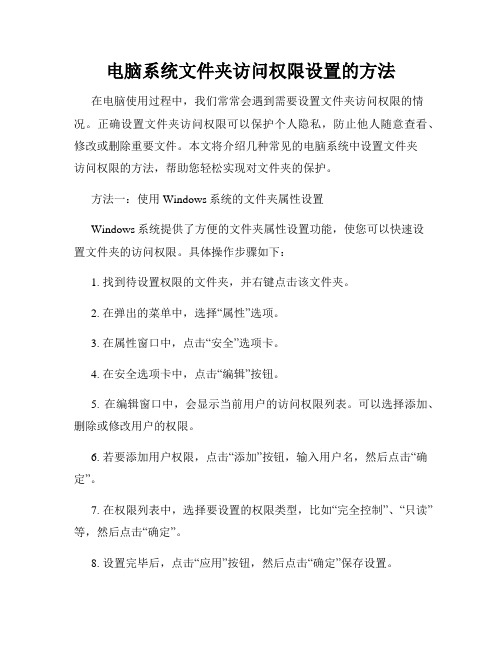
电脑系统文件夹访问权限设置的方法在电脑使用过程中,我们常常会遇到需要设置文件夹访问权限的情况。
正确设置文件夹访问权限可以保护个人隐私,防止他人随意查看、修改或删除重要文件。
本文将介绍几种常见的电脑系统中设置文件夹访问权限的方法,帮助您轻松实现对文件夹的保护。
方法一:使用Windows系统的文件夹属性设置Windows系统提供了方便的文件夹属性设置功能,使您可以快速设置文件夹的访问权限。
具体操作步骤如下:1. 找到待设置权限的文件夹,并右键点击该文件夹。
2. 在弹出的菜单中,选择“属性”选项。
3. 在属性窗口中,点击“安全”选项卡。
4. 在安全选项卡中,点击“编辑”按钮。
5. 在编辑窗口中,会显示当前用户的访问权限列表。
可以选择添加、删除或修改用户的权限。
6. 若要添加用户权限,点击“添加”按钮,输入用户名,然后点击“确定”。
7. 在权限列表中,选择要设置的权限类型,比如“完全控制”、“只读”等,然后点击“确定”。
8. 设置完毕后,点击“应用”按钮,然后点击“确定”保存设置。
通过这种方式,您可以根据需要对文件夹的权限进行灵活的设置,实现精细化的访问控制。
方法二:使用Mac系统的访问控制列表(ACL)Mac系统提供了访问控制列表(ACL)功能,可以实现更细粒度的文件夹权限设置。
下面是使用ACL设置文件夹访问权限的方法:1. 打开“终端”应用程序,输入命令“sudo chmod +a '用户名 allow 权限类型' 文件夹路径”,回车确认。
例如,要给用户“John”赋予对文件夹“Documents”的读写权限,命令可以是“sudo chmod +a 'John allow read,write' ~/Documents”。
2. 系统会要求您输入管理员密码,输入密码后按回车确认。
3. 设置完成后,您可以通过命令“ls -le 文件夹路径”来查看文件夹的ACL权限设置。
使用ACL设置访问权限可以更加精确地控制用户对文件夹的访问权限,适用于有较高安全需求的用户。
Linux命令行使用技巧如何使用chmod命令进行批量权限修改
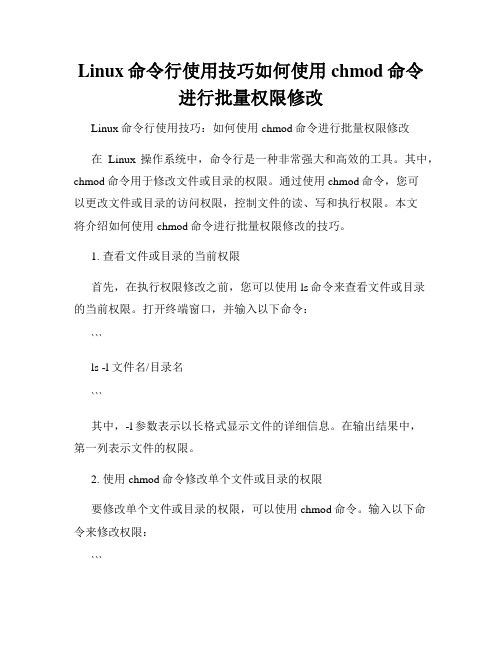
Linux命令行使用技巧如何使用chmod命令进行批量权限修改Linux命令行使用技巧:如何使用chmod命令进行批量权限修改在Linux操作系统中,命令行是一种非常强大和高效的工具。
其中,chmod命令用于修改文件或目录的权限。
通过使用chmod命令,您可以更改文件或目录的访问权限,控制文件的读、写和执行权限。
本文将介绍如何使用chmod命令进行批量权限修改的技巧。
1. 查看文件或目录的当前权限首先,在执行权限修改之前,您可以使用ls命令来查看文件或目录的当前权限。
打开终端窗口,并输入以下命令:```ls -l 文件名/目录名```其中,-l参数表示以长格式显示文件的详细信息。
在输出结果中,第一列表示文件的权限。
2. 使用chmod命令修改单个文件或目录的权限要修改单个文件或目录的权限,可以使用chmod命令。
输入以下命令来修改权限:```chmod 权限模式文件名/目录名```其中,权限模式有两种常用的表示方式:符号模式和数字模式。
- 使用符号模式修改权限:符号模式通过使用“+”、“-”和“=”来表示权限的增加、删除和设置。
例如,要将文件的所有者权限设为可读、可写、可执行,可以使用以下命令:```chmod u=rwx 文件名/目录名```其中,u表示所有者,rwx分别表示可读、可写和可执行。
相应地,可以使用g(群组)、o(其他用户)和a(所有用户)来指定不同的用户组。
- 使用数字模式修改权限:数字模式通过数字来表示权限。
每个权限有一个特定的数字表示,r(可读)为4,w(可写)为2,x(可执行)为1。
通过将这些数字相加,您可以设置所需的权限。
例如,要将文件的权限设置为所有者可读、可写、可执行,群组和其他用户只读的权限,可以使用以下命令:```chmod 744 文件名/目录名```其中,7表示所有者的权限,4表示群组和其他用户的权限。
3. 使用chmod命令进行批量权限修改若要批量修改文件或目录的权限,可以结合使用find命令和chmod 命令。
文件夹权限的批量修改
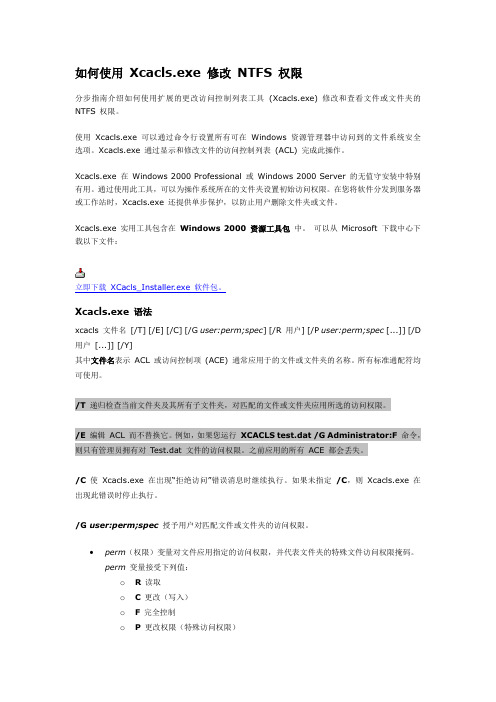
如何使用Xcacls.exe 修改NTFS 权限分步指南介绍如何使用扩展的更改访问控制列表工具(Xcacl s.exe) 修改和查看文件或文件夹的NTFS 权限。
使用Xcacls.ex e 可以通过命令行设置所有可在Windows 资源管理器中访问到的文件系统安全选项。
Xcacls.exe 通过显示和修改文件的访问控制列表(ACL) 完成此操作。
Xcacls.exe 在Windows 2000 Professional 或 Windows 2000 Server 的无值守安装中特别有用。
通过使用此工具,可以为操作系统所在的文件夹设置初始访问权限。
在您将软件分发到服务器或工作站时,Xcacls.exe 还提供单步保护,以防止用户删除文件夹或文件。
Xcacls.exe 实用工具包含在Windows 2000 资源工具包中。
可以从 Microsoft 下载中心下载以下文件:立即下载XCacls_Installer.exe 软件包。
Xcacls.exe 语法xcacls 文件名[/T] [/E] [/C] [/G user:perm;spec] [/R 用户] [/P user:perm;spec [...]] [/D 用户[...]] [/Y]其中文件名表示ACL 或访问控制项(ACE) 通常应用于的文件或文件夹的名称。
所有标准通配符均可使用。
/T递归检查当前文件夹及其所有子文件夹,对匹配的文件或文件夹应用所选的访问权限。
/E编辑ACL 而不替换它。
例如,如果您运行XCACLS test.dat /G Administrator:F命令,则只有管理员拥有对 Test.dat 文件的访问权限。
之前应用的所有ACE 都会丢失。
/C使 Xcacls.exe 在出现“拒绝访问”错误消息时继续执行。
如果未指定/C,则Xcacls.exe 在出现此错误时停止执行。
/G user:perm;spec授予用户对匹配文件或文件夹的访问权限。
Linux命令高级技巧使用chown和chmod命令批量修改文件和的权限
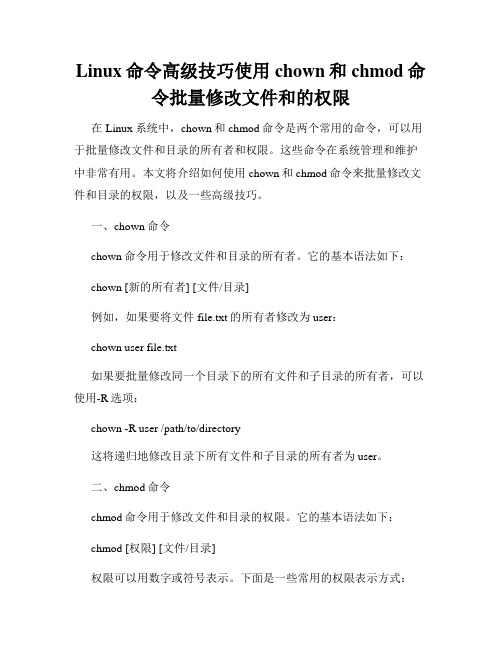
Linux命令高级技巧使用chown和chmod命令批量修改文件和的权限在Linux系统中,chown和chmod命令是两个常用的命令,可以用于批量修改文件和目录的所有者和权限。
这些命令在系统管理和维护中非常有用。
本文将介绍如何使用chown和chmod命令来批量修改文件和目录的权限,以及一些高级技巧。
一、chown命令chown命令用于修改文件和目录的所有者。
它的基本语法如下:chown [新的所有者] [文件/目录]例如,如果要将文件file.txt的所有者修改为user:chown user file.txt如果要批量修改同一个目录下的所有文件和子目录的所有者,可以使用-R选项:chown -R user /path/to/directory这将递归地修改目录下所有文件和子目录的所有者为user。
二、chmod命令chmod命令用于修改文件和目录的权限。
它的基本语法如下:chmod [权限] [文件/目录]权限可以用数字或符号表示。
下面是一些常用的权限表示方式:- r(读):4- w(写):2- x(执行):1例如,如果要将文件file.txt的权限设置为读写,可以使用以下命令:chmod 600 file.txt如果要批量修改同一个目录下的所有文件和子目录的权限,可以使用-R选项:chmod -R 600 /path/to/directory这将递归地修改目录下所有文件和子目录的权限为600。
三、批量修改文件和目录的所有者和权限有时,我们需要同时修改文件和目录的所有者和权限。
可以结合使用chown和chmod命令来实现。
例如,如果要将文件file.txt的所有者修改为user,并将权限设置为读写,可以使用以下命令:chown user file.txtchmod 600 file.txt如果要批量修改同一个目录下的所有文件和子目录的所有者和权限,可以使用-R选项:chown -R user /path/to/directorychmod -R 600 /path/to/directory这将递归地修改目录下所有文件和子目录的所有者为user,并将权限设置为600。
Windows应用场景下批量修改文件权限的批处理脚本
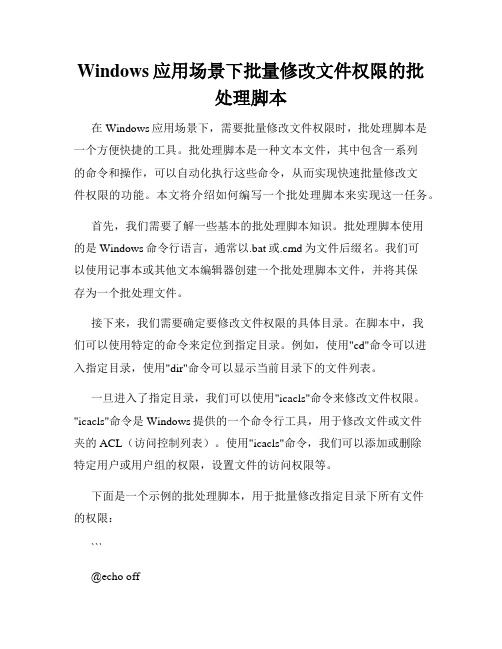
Windows应用场景下批量修改文件权限的批处理脚本在Windows应用场景下,需要批量修改文件权限时,批处理脚本是一个方便快捷的工具。
批处理脚本是一种文本文件,其中包含一系列的命令和操作,可以自动化执行这些命令,从而实现快速批量修改文件权限的功能。
本文将介绍如何编写一个批处理脚本来实现这一任务。
首先,我们需要了解一些基本的批处理脚本知识。
批处理脚本使用的是Windows命令行语言,通常以.bat或.cmd为文件后缀名。
我们可以使用记事本或其他文本编辑器创建一个批处理脚本文件,并将其保存为一个批处理文件。
接下来,我们需要确定要修改文件权限的具体目录。
在脚本中,我们可以使用特定的命令来定位到指定目录。
例如,使用"cd"命令可以进入指定目录,使用"dir"命令可以显示当前目录下的文件列表。
一旦进入了指定目录,我们可以使用"icacls"命令来修改文件权限。
"icacls"命令是Windows提供的一个命令行工具,用于修改文件或文件夹的ACL(访问控制列表)。
使用"icacls"命令,我们可以添加或删除特定用户或用户组的权限,设置文件的访问权限等。
下面是一个示例的批处理脚本,用于批量修改指定目录下所有文件的权限:```@echo offsetlocalREM 进入指定目录cd C:\Path\to\DirectoryREM 修改文件权限for /R %%G in (*) do (icacls "%%G" /grant Users:(RX))endlocal```在上述脚本中,"cd"命令指定了要修改权限的目录,这里是"C:\Path\to\Directory"。
然后使用"for /R"命令遍历该目录下的所有文件,并使用"icacls"命令给所有文件添加了"Users"用户组的读取和执行权限。
Linux命令技巧批量修改文件和属性
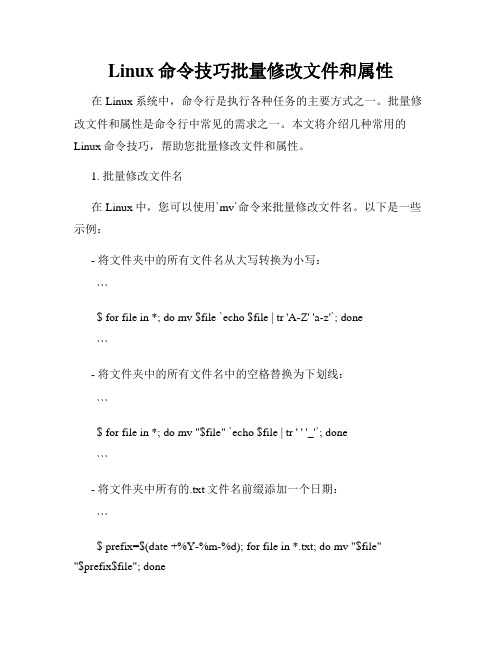
Linux命令技巧批量修改文件和属性在Linux系统中,命令行是执行各种任务的主要方式之一。
批量修改文件和属性是命令行中常见的需求之一。
本文将介绍几种常用的Linux命令技巧,帮助您批量修改文件和属性。
1. 批量修改文件名在Linux中,您可以使用`mv`命令来批量修改文件名。
以下是一些示例:- 将文件夹中的所有文件名从大写转换为小写:```$ for file in *; do mv $file `echo $file | tr 'A-Z' 'a-z'`; done```- 将文件夹中的所有文件名中的空格替换为下划线:```$ for file in *; do mv "$file" `echo $file | tr ' ' '_'`; done```- 将文件夹中所有的.txt文件名前缀添加一个日期:```$ prefix=$(date +%Y-%m-%d); for file in *.txt; do mv "$file" "$prefix$file"; done```2. 批量修改文件内容有时,您需要批量修改文件的内容,可以使用`sed`命令来实现。
以下是一些示例:- 将文件夹中所有文件中的"apple"替换为"orange":```$ sed -i 's/apple/orange/g' *```- 在文件夹中所有文件的开头添加一行注释:```$ sed -i '1i# This is a comment' *```- 在所有.html文件中查找并替换特定的URL:```$ find . -name "*.html" -exec sed -i 's/original_url/new_url/g' {} \;```3. 批量修改文件权限和属性在Linux中,使用`chmod`命令可以修改文件权限,使用`chown`和`chgrp`命令可以修改文件的所有者和所属组。
Windows CMD中文件权限和属性的管理方法
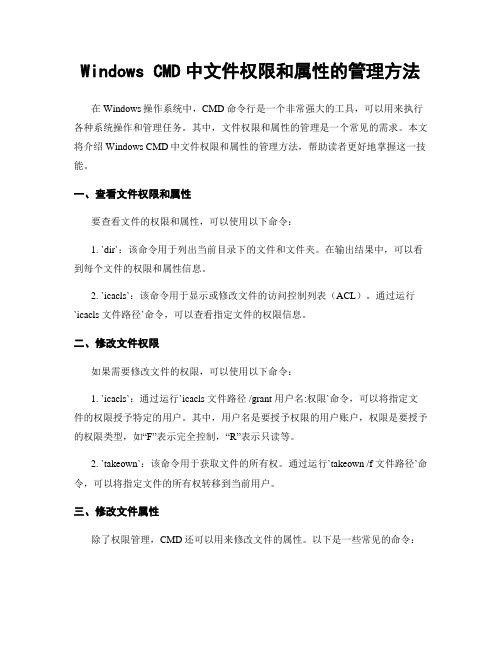
Windows CMD中文件权限和属性的管理方法在Windows操作系统中,CMD命令行是一个非常强大的工具,可以用来执行各种系统操作和管理任务。
其中,文件权限和属性的管理是一个常见的需求。
本文将介绍Windows CMD中文件权限和属性的管理方法,帮助读者更好地掌握这一技能。
一、查看文件权限和属性要查看文件的权限和属性,可以使用以下命令:1. `dir`:该命令用于列出当前目录下的文件和文件夹。
在输出结果中,可以看到每个文件的权限和属性信息。
2. `icacls`:该命令用于显示或修改文件的访问控制列表(ACL)。
通过运行`icacls 文件路径`命令,可以查看指定文件的权限信息。
二、修改文件权限如果需要修改文件的权限,可以使用以下命令:1. `icacls`:通过运行`icacls 文件路径 /grant 用户名:权限`命令,可以将指定文件的权限授予特定的用户。
其中,用户名是要授予权限的用户账户,权限是要授予的权限类型,如“F”表示完全控制,“R”表示只读等。
2. `takeown`:该命令用于获取文件的所有权。
通过运行`takeown /f 文件路径`命令,可以将指定文件的所有权转移到当前用户。
三、修改文件属性除了权限管理,CMD还可以用来修改文件的属性。
以下是一些常见的命令:1. `attrib`:该命令用于修改文件的属性。
通过运行`attrib +属性文件路径`命令,可以给指定文件添加属性;通过运行`attrib -属性文件路径`命令,可以从指定文件中删除属性。
常见的属性包括“只读”(R)、“隐藏”(H)和“系统文件”(S)等。
2. `cacls`:该命令用于显示或修改文件的访问控制列表(ACL)。
通过运行`cacls 文件路径 /e /p 用户名:权限`命令,可以修改指定文件的权限。
其中,/e参数表示编辑ACL,/p参数表示授予特定用户权限。
四、批量操作文件权限和属性如果需要对多个文件进行权限和属性的批量操作,可以使用批处理脚本。
怎样在Windows系统中修改文件权限
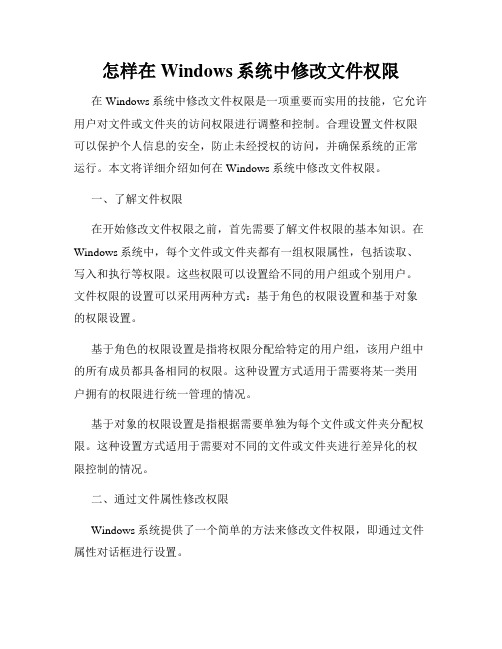
怎样在Windows系统中修改文件权限在Windows系统中修改文件权限是一项重要而实用的技能,它允许用户对文件或文件夹的访问权限进行调整和控制。
合理设置文件权限可以保护个人信息的安全,防止未经授权的访问,并确保系统的正常运行。
本文将详细介绍如何在Windows系统中修改文件权限。
一、了解文件权限在开始修改文件权限之前,首先需要了解文件权限的基本知识。
在Windows系统中,每个文件或文件夹都有一组权限属性,包括读取、写入和执行等权限。
这些权限可以设置给不同的用户组或个别用户。
文件权限的设置可以采用两种方式:基于角色的权限设置和基于对象的权限设置。
基于角色的权限设置是指将权限分配给特定的用户组,该用户组中的所有成员都具备相同的权限。
这种设置方式适用于需要将某一类用户拥有的权限进行统一管理的情况。
基于对象的权限设置是指根据需要单独为每个文件或文件夹分配权限。
这种设置方式适用于需要对不同的文件或文件夹进行差异化的权限控制的情况。
二、通过文件属性修改权限Windows系统提供了一个简单的方法来修改文件权限,即通过文件属性对话框进行设置。
1. 首先,选中需要修改权限的文件或文件夹,右键点击并选择“属性”。
2. 在弹出的属性对话框中,点击“安全”选项卡。
3. 在“安全”选项卡中,可以看到文件或文件夹的当前权限设置。
点击“编辑”按钮,即可进行权限的修改。
4. 在权限编辑对话框中,可以看到已有的用户组或用户列表。
点击需要修改的用户组或用户,然后在“允许”和“拒绝”列勾选或取消权限选项。
5. 点击“确定”按钮保存修改后的权限设置。
通过文件属性修改权限是一种简单直观的方式,适用于对少量文件或文件夹进行权限设置。
然而,当需要为大量文件或文件夹进行批量权限设置时,可以采用基于命令行的方式进行操作。
三、通过命令行修改权限Windows系统提供了一组命令行工具来修改文件权限,包括ICACLS和CACLS等。
1. 首先,打开命令提示符。
Linux命令高级技巧利用find与xargs命令进行批量文件权限的修改与管理的高级技术

Linux命令高级技巧利用find与xargs命令进行批量文件权限的修改与管理的高级技术在Linux系统中,find与xargs命令是实现批量文件权限修改与管理的高级技术。
利用这两个命令的强大功能,我们可以轻松地对文件或目录进行权限的批量修改,提高工作效率。
本文将介绍Linux命令高级技巧,详细解释find与xargs命令的使用方法,并提供实例演示。
一、find命令的基本使用find命令是Linux系统中常用的查找文件和目录的命令。
它支持根据文件名、文件类型、文件时间等多个条件进行搜索,具有非常强大的灵活性。
下面是find命令的基本语法:find [path] [expression]其中,path表示要进行搜索的路径,可以是绝对路径或相对路径。
expression表示搜索的条件,可以是文件名、文件类型、文件大小等。
1.1 根据文件名查找我们可以使用find命令根据文件名查找文件或目录。
以下是一个例子:```shellfind /home -name test.txt```上述命令将在/home目录下查找文件名为test.txt的文件。
如果要查找某个目录及其子目录下的文件,可以使用通配符*:```shellfind /home -name "*.txt"```上述命令将查找/home目录及其子目录下的所有以.txt结尾的文件。
1.2 根据文件类型查找除了根据文件名查找,find命令还支持根据文件类型进行查找。
以下是一个例子:```shellfind /home -type f```上述命令将在/home目录下查找所有的文件。
同样地,我们可以使用不同的参数来搜索特定类型的文件。
例如,要查找所有的目录,可以使用参数-d:```shellfind /home -type d```1.3 根据文件时间查找find命令还可以通过文件的修改时间或访问时间进行搜索。
以下是一个例子:```shellfind /home -mtime +7```上述命令将在/home目录下查找所有7天前被修改的文件。
windows应用场景下批量修改文件夹权限的批处理脚本
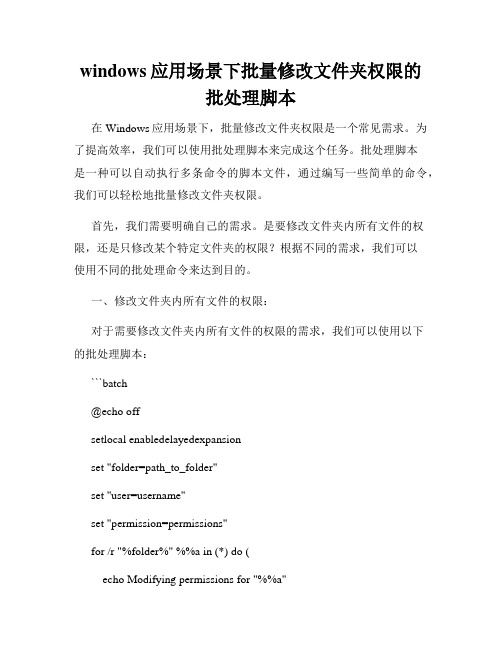
windows应用场景下批量修改文件夹权限的批处理脚本在Windows应用场景下,批量修改文件夹权限是一个常见需求。
为了提高效率,我们可以使用批处理脚本来完成这个任务。
批处理脚本是一种可以自动执行多条命令的脚本文件,通过编写一些简单的命令,我们可以轻松地批量修改文件夹权限。
首先,我们需要明确自己的需求。
是要修改文件夹内所有文件的权限,还是只修改某个特定文件夹的权限?根据不同的需求,我们可以使用不同的批处理命令来达到目的。
一、修改文件夹内所有文件的权限:对于需要修改文件夹内所有文件的权限的需求,我们可以使用以下的批处理脚本:```batch@echo offsetlocal enabledelayedexpansionset "folder=path_to_folder"set "user=username"set "permission=permissions"for /r "%folder%" %%a in (*) do (echo Modifying permissions for "%%a"cacls "%%a" /e /g "%user%:%permission%")echo All permissions modified.pause```在脚本中,我们需要根据自己的实际情况修改几个变量的值:- `folder`:需要修改权限的文件夹路径。
- `user`:要添加权限的用户名。
- `permission`:要设置的权限。
将以上脚本中的这三个变量值修改为你的实际需求,保存为一个以`.bat`为后缀的批处理脚本文件,双击运行即可批量修改文件夹内所有文件的权限。
二、修改特定文件夹的权限:对于只需要修改特定文件夹权限的需求,我们可以使用以下的批处理脚本:```batch@echo offset "folder=path_to_folder"set "user=username"set "permission=permissions"echo Modifying permissions for "%folder%"cacls "%folder%" /e /g "%user%:%permission%"echo Permissions modified.pause```在这个脚本中,我们同样需要修改三个变量的值:- `folder`:需要修改权限的文件夹路径。
实用技巧在Shell脚本中使用文件权限管理数据访问

实用技巧在Shell脚本中使用文件权限管理数据访问文件权限是Shell脚本中重要的数据访问管理工具。
熟练掌握文件权限的实用技巧可以提高脚本的安全性和效率。
本文将介绍在Shell脚本中使用文件权限管理数据访问的实用技巧。
一、文件权限基础文件权限是操作系统中对文件和目录进行权限控制的机制。
在Linux系统中,每个文件和目录都有三种基本权限:读(r)、写(w)和执行(x)。
这三种权限分别用数字表示为4、2和1,通过组合可以得到不同的权限掩码。
例如,用户可读可写但不可执行的权限表示为6(4+2),用户可读不可写不可执行的权限表示为4,用户不可读不可写但可执行的权限表示为1。
二、查看文件权限通过ls命令可以查看文件的权限信息。
具体命令格式为:```ls -l 文件名```其中,-l选项表示以长格式显示文件信息。
在权限信息的第一列,分别以r、w和x表示文件所有者、文件所属组和其他用户对文件的权限。
三、修改文件权限1. 使用chmod命令修改文件权限。
具体命令格式为:```chmod [who][+-=][权限] 文件名```其中,who表示欲修改权限的对象,可以是u(所有者)、g(所属组)和o(其他用户),也可以是a(所有用户)。
+-=表示增加、减少和设置权限。
权限表示为r、w或x的组合。
例如,将文件的所有者权限设置为可写可执行,可以执行如下命令:```chmod u+wx 文件名```2. 使用数字修改文件权限。
每个权限对应一个数值,通过组合可以得到权限掩码。
例如,读写权限对应的数值是6,只读权限对应的数值是4。
通过chmod命令也可以使用数值来设置权限。
例如,将文件的所有者权限设置为可读可写可执行,可以执行如下命令:```chmod 700 文件名```其中,700表示用户权限为7(读、写和执行),而所属组和其他用户的权限均为0(无权限)。
四、文件权限的实用技巧1. 判断文件是否存在并具有读写权限在脚本中,我们经常需要判断某个文件是否存在并具有读写权限,以决定是否继续执行下一步操作。
利用Windows CMD命令批量修改文件属性的技巧
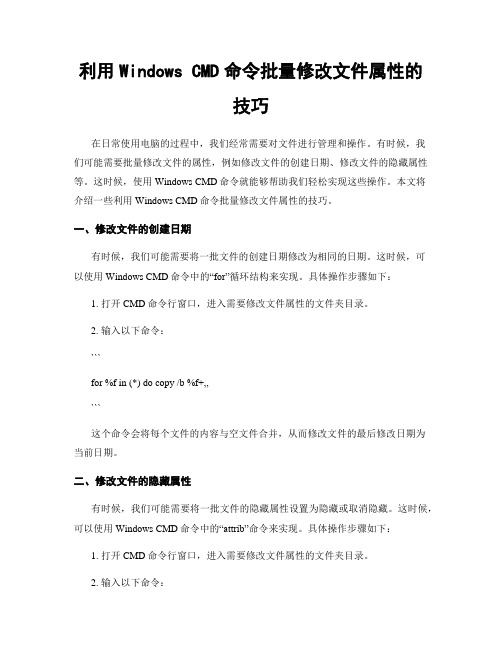
利用Windows CMD命令批量修改文件属性的技巧在日常使用电脑的过程中,我们经常需要对文件进行管理和操作。
有时候,我们可能需要批量修改文件的属性,例如修改文件的创建日期、修改文件的隐藏属性等。
这时候,使用Windows CMD命令就能够帮助我们轻松实现这些操作。
本文将介绍一些利用Windows CMD命令批量修改文件属性的技巧。
一、修改文件的创建日期有时候,我们可能需要将一批文件的创建日期修改为相同的日期。
这时候,可以使用Windows CMD命令中的“for”循环结构来实现。
具体操作步骤如下:1. 打开CMD命令行窗口,进入需要修改文件属性的文件夹目录。
2. 输入以下命令:```for %f in (*) do copy /b %f+,,```这个命令会将每个文件的内容与空文件合并,从而修改文件的最后修改日期为当前日期。
二、修改文件的隐藏属性有时候,我们可能需要将一批文件的隐藏属性设置为隐藏或取消隐藏。
这时候,可以使用Windows CMD命令中的“attrib”命令来实现。
具体操作步骤如下:1. 打开CMD命令行窗口,进入需要修改文件属性的文件夹目录。
2. 输入以下命令:attrib +h *.txt```这个命令会将当前目录下所有的txt文件的隐藏属性设置为隐藏。
三、批量修改文件的扩展名有时候,我们可能需要将一批文件的扩展名进行修改,例如将.jpg文件修改为.png文件。
这时候,可以使用Windows CMD命令中的“ren”命令来实现。
具体操作步骤如下:1. 打开CMD命令行窗口,进入需要修改文件属性的文件夹目录。
2. 输入以下命令:```ren *.jpg *.png```这个命令会将当前目录下所有的jpg文件的扩展名修改为png。
四、修改文件的只读属性有时候,我们可能需要将一批文件的只读属性设置或取消。
这时候,可以使用Windows CMD命令中的“attrib”命令来实现。
具体操作步骤如下:1. 打开CMD命令行窗口,进入需要修改文件属性的文件夹目录。
- 1、下载文档前请自行甄别文档内容的完整性,平台不提供额外的编辑、内容补充、找答案等附加服务。
- 2、"仅部分预览"的文档,不可在线预览部分如存在完整性等问题,可反馈申请退款(可完整预览的文档不适用该条件!)。
- 3、如文档侵犯您的权益,请联系客服反馈,我们会尽快为您处理(人工客服工作时间:9:00-18:30)。
如何使用Xcacls.exe 修改NTFS 权限本页∙概要o Xcacls.exe 语法o使用Xcacls.exe 查看权限o Xcacls.exe 示例▪示例1▪示例2▪示例3o NTFS 权限原则∙参考展开全部| 关闭全部本分步指南介绍如何使用扩展的更改访问控制列表工具(Xcacls.exe) 修改和查看文件或文件夹的NTFS 权限。
使用Xcacls.exe 可以通过命令行设置所有可在Windows 资源管理器中访问到的文件系统安全选项。
Xcacls.exe 通过显示和修改文件的访问控制列表(ACL) 完成此操作。
Xcacls.exe 在Windows 2000 Professional 或Windows 2000 Server 的无值守安装中特别有用。
通过使用此工具,可以为操作系统所在的文件夹设置初始访问权限。
在您将软件分发到服务器或工作站时,Xcacls.exe 还提供单步保护,以防止用户删除文件夹或文件。
Xcacls.exe 实用工具包含在Windows 2000 资源工具包中。
可以从Microsoft 下载中心下载以下文件:立即下载XCacls_Installer.exe 软件包。
回到顶端Xcacls.exe 语法xcacls 文件名[/T] [/E] [/C] [/G user:perm;spec] [/R 用户] [/P user:perm;spec [...]] [/D 用户[...]] [/Y]其中文件名表示ACL 或访问控制项(ACE) 通常应用于的文件或文件夹的名称。
所有标准通配符均可使用。
/T递归检查当前文件夹及其所有子文件夹,对匹配的文件或文件夹应用所选的访问权限。
/E编辑ACL 而不替换它。
例如,如果您运行XCACLS test.dat /G Administrator:F命令,则只有管理员拥有对Test.dat 文件的访问权限。
之前应用的所有ACE 都会丢失。
/C使Xcacls.exe 在出现“拒绝访问”错误消息时继续执行。
如果未指定/C,则Xcacls.exe 在出现此错误时停止执行。
/G user:perm;spec授予用户对匹配文件或文件夹的访问权限。
∙perm(权限)变量对文件应用指定的访问权限,并代表文件夹的特殊文件访问权限掩码。
perm变量接受下列值:o R读取o C更改(写入)o F完全控制o P更改权限(特殊访问权限)o O取得所有权(特殊访问权限)o X执行(特殊访问权限)o E读取(特殊访问权限)o W写入(特殊访问权限)o D删除(特殊访问权限)∙spec(特殊访问权限)变量仅应用于文件夹,它除了接受与perm相同的值以外,还接受以下特殊值:o T未指定。
为目录本身设置ACE,而不指定应用于在该目录中创建的新文件的ACE。
至少存在一个要遵循的访问权限。
分号(;) 和T 之间的项将被忽略。
注意:▪文件的访问权限选项(针对文件夹、特殊文件和文件夹访问)是完全相同的。
有关这些选项的详细说明,请参阅Windows 2000 操作系统的文档。
▪所有其他选项(它们也可以在Windows 资源管理器中设置)都是基本访问权限的所有可能组合的子集。
因此,不存在文件夹访问权限(如LIST 或READ)的特殊选项。
/R 用户为指定用户调用所有访问权限。
/P user:perm;spec替换用户的访问权限。
指定perm 和spec 的规则与/G 选项相同。
请参阅本文的“Xcacls.exe 示例”部分。
/D 用户拒绝用户访问文件或目录。
/Y禁止在替换用户访问权限时出现确认提示。
默认情况下,CACLS 要求确认。
由于存在此功能,在批处理例程中使用CACLS 时,例程将停止响应并等待输入正确答案。
引入/Y选项后可消除此确认,从而可以在批处理模式下使用Xcacls.exe。
回到顶端使用Xcacls.exe 查看权限Xcacls.exe 还可用于查看文件或文件夹的权限。
例如,在命令提示符处键入xcacls C:\winnt,然后按Enter。
下面是典型结果:c:\WINNT BUILTIN\Users:RBUILTIN\Users:(OI)(CI)(IO)(special access:)GENERIC_READGENERIC_EXECUTEBUILTIN\Power Users:CBUILTIN\Power Users:(OI)(CI)(IO)CBUILTIN\Administrators:FBUILTIN\Administrators:(OI)(CI)(IO)FNT AUTHORITY\SYSTEM:FNT AUTHORITY\SYSTEM:(OI)(CI)(IO)FBUILTIN\Administrators:FCREATOR OWNER:(OI)(CI)(IO)F这些ACL 标志具有下列含义:∙IO:仅继承—此标志表示此ACE 不应用于当前对象。
∙CI:容器继承—此标志表示从属容器将继承此ACE。
∙OI:对象继承—此标志表示从属文件将继承该ACE。
∙NP:不传播—此标志表示从属对象不继续传播继承的ACE。
每行末尾的字母表示权限。
例如:∙F:完全控制∙C:更改∙W:写入回到顶端Xcacls.exe 示例示例 1在命令提示符下键入XCACLS *.* /G administrator:RW /Y,然后按Enter 以替换当前文件夹中所有文件和文件夹的ACL,而不扫描子文件夹且不进行确认。
示例 2在本示例中,添加到文件夹的ACE 还将继承在此文件夹中创建的新文件的ACE。
该命令授予TestUser 对此文件夹中的所有新建文件的读取、写入、运行和删除权限,但只授予对文件夹本身的读写权限。
在命令提示符下键入XCACLS *.* /G TestUser:RWED;RW /E,然后按Enter。
示例 3下面的示例将授予对文件夹的读写权限,而不为新文件创建继承项。
因此,在本示例中,此文件夹中的新建文件不会收到TestUser 的ACE。
对于现有文件,将创建具有读取权限的ACE。
在命令提示符下键入XCACLS *.* /G TestUser:R;RW /E,然后按Enter。
回到顶端NTFS 权限原则下面是分配NTFS 权限的原则:∙使用NTFS 权限控制对文件和文件夹的访问。
∙将权限分配给组而不是单独用户。
∙NTFS 文件权限优先于NTFS 文件夹权限。
∙管理员以及文件或文件夹的所有者控制可为该对象设置的权限。
∙在更改文件夹权限时,应了解服务器上安装的程序。
程序会创建自己的文件夹并打开“允许从父系来的继承权限传播到这个对象”设置。
如果更改了父文件夹中的权限,则这些更改可能会导致程序中出现问题。
警告:请记住,许多文件和文件夹通过继承接收权限。
因此,在您认为只是更改了一个文件夹时,您可能更改了其他更多内容。
如何使用Xcacls.vbs 修改NTFS 权限Microsoft 以Microsoft Visual Basic 脚本(Xcacls.vbs) 的形式提供了Extended Change Access Control List(扩展更改访问控制列表)工具(Xcacls.exe) 的更新版本。
本文分步介绍如何使用Xcacls.vbs 脚本修改和查看文件或文件夹的NTFS 文件系统权限。
可以从命令行使用Xcacls.vbs 设置所有可在Microsoft Windows 资源管理器中访问的文件系统安全选项。
Xcacls.vbs 可显示和修改文件的访问控制列表(ACL)。
注意:Xcacls.vbs 只与Microsoft Windows 2000、Microsoft Windows XP 和Microsoft Windows Server 2003 兼容。
Microsoft 不支持Xcacls.vbs。
回到顶端设置和使用Xcacls.vbs要设置和使用Xcacls.vbs,请按照下列步骤操作:1.从以下Microsoft 网站获得Xcacls.vbs 的最新版本:/download/f/7/8/f786aaf3-a37b-45ab-b0a2-8c8 c18bbf483/XCacls_Installer.exe2.双击“Xcacls_Installer.exe”。
当提示您提供放置提取文件的位置时,请指定一个位于计算机的搜索路径设置中的文件夹(如C:\Windows)。
3.将默认脚本引擎从Wscript 更改为Cscript。
(Xcacls.vbs 脚本最适合在Cscript 下运行。
)为此,请在命令提示符下键入以下内容,然后按Enter:cscript.exe /h:cscript注意:将默认脚本引擎更改为Cscript 只影响脚本向屏幕写入的方式。
Wscript 根据“确定”对话框分别写入每一行。
Cscript 将每一行写入命令窗口。
如果您不想更改默认脚本引擎,则必须使用以下命令运行脚本cscript.exe xcacls.vbs但是,如果将默认脚本更改为Cscript,则可以使用以下命令运行该脚本:xcacls.vbs.4.要查看Xcacls.vbs 的命令语法,请在命令提示符处键入下面的命令:xcacls.vbs /?Xcacls.vbs 命令的语法下面xcacls.vbs /?命令的输出描述了Xcacls.vbs 命令的语法:Usage:XCACLS filename [/E] [/G user:perm;spec] [...] [/R user [...]] [/F] [/S] [/T][/P user:perm;spec [...]] [/D user:perm;spec] [...][/O user] [/I ENABLE/COPY/REMOVE] [/N[/L filename] [/Q] [/DEBUG]filename [Required] If used alone, it displays ACLs.(Filename can be a filename, directory name orwildcard characters and can include the wholepath. If path is missing, it is assumed to beunder the current directory.)Notes:- Put filename in quotes if it has spaces orspecial characters such as &, $, #, etc. - If filename is a directory, all files andsubdirectories under it will NOT be changedunless the /F or S is present./F [Used with Directory or Wildcard] This will change allfiles under the inputted directory but will NOTtraverse subdirectories unless /T is also present.If filename is a directory, and /F is not used, nofiles will be touched./S [Used with Directory or Wildcard] This will change allsubfolders under the inputted directory but will NOTtraverse subdirectories unless /T is also present.If filename is a directory, and /S is not used, nosubdirectories will be touched./T [Used only with a Directory] Traverses eachsubdirectory and makes the same changes. This switch will traverse directories only if thefilename is a directory or is using wildcard characters./E Edit ACL instead of replacing it./G user:GUI Grant security permissions similar to Windows GUIstandard (non-advanced) choices./G user:Perm;Spec Grant specified user access rights. (/G adds to existing rights for user)User: If User has spaces in it, enclose it in quotes.If User contains #machine#, it will replace#machine# with the actual machine name if it is anon-domain controller, and replace it with theactual domain name if it is a domain controller.New to 3.0: User can be a string representingthe actual SID, but MUST be lead by SID#Example:SID#S-1-5-21-2127521184-160...(SID string shown has been shortened)(If any user has SID# then globally allmatches must match the SID (not name)so if your intention is to apply changesto all accounts that match Domain\Userthen do not specify SID# as one of theusers.)GUI: Is for standard rights and can be: Permissions...F Full controlM ModifyX read and eXecuteL List folder contentsR ReadW WriteNote: If a ; is present, this will be considereda Perm;Spec parameter pair.Perm: Is for "Files Only" and can be: Permissions...F Full controlM ModifyX read and eXecuteR ReadW WriteAdvanced...D Take OwnershipC Change PermissionsB Read PermissionsA Delete9 Write Attributes8 Read Attributes7 Delete Subfolders and Files6 Traverse Folder / Execute File5 Write Extended Attributes 4 Read Extended Attributes 3 Create Folders / Append Data2 Create Files / Write Data 1 List Folder / Read DataSpec is for "Folder and Subfolders only" and has thesame choices as Perm./R user Revoke specified user's access rights. (Will remove any Allowed or Denied ACL's for user.)/P user:GUI Replace security permissions similar to standard choices./P user:perm;spec Replace specified user's access rights.For access right specification see /G option.(/P behaves like /G if there are no rights set for user.)/D user:GUI Deny security permissions similar to standard choices./D user:perm;spec Deny specified user access rights. For access right specification see /G option.(/D adds to existing rights for user.)/O user Change the Ownership to this user or group./I switch Inheritance flag. If omitted, the default is to not touchInherited ACL's. Switch can be:ENABLE - This will turn on the Inheritance flag ifit is not on already.COPY - This will turn off the Inheritance flag andcopy the Inherited ACL'sinto Effective ACL's.REMOVE - This will turn off the Inheritance flag andwill not copy the Inherited ACL's. This is the opposite of ENABLE.If switch is not present, /I will be ignored andInherited ACL's will remain untouched./L filename Filename for Logging. This can include a path nameif the file is not under the current directory.File will be appended to, or created if it does notexit. Must be Text file if it exists or error will occur.If filename is omitted, the default name of XCACLS willbe used./Q Turn on Quiet mode. By default, it is off.If it is turned on, there will be no display to the screen./DEBUG Turn on Debug mode. By default, it is off. If it is turned on, there will be more informationdisplayed and/or logged. Information will showSub/Function Enter and Exit as well as other importantinformation./SERVER servername Enter a remote server to run script against./USER username Enter Username to impersonate for Remote Connections(requires PASS switch). Will be ignored if it is for a Local Connection./PASS password Enter Password to go with USER switch (requires USER switch).Wildcard characters can be used to specify more than one file in a command, such as:* Any string of zero or more characters? Any single characterYou can specify more than one user in a command.You can combine access rights.使用Xcacls.vbs 查看权限Xcacls.vbs 还可用于查看文件或文件夹的权限。
